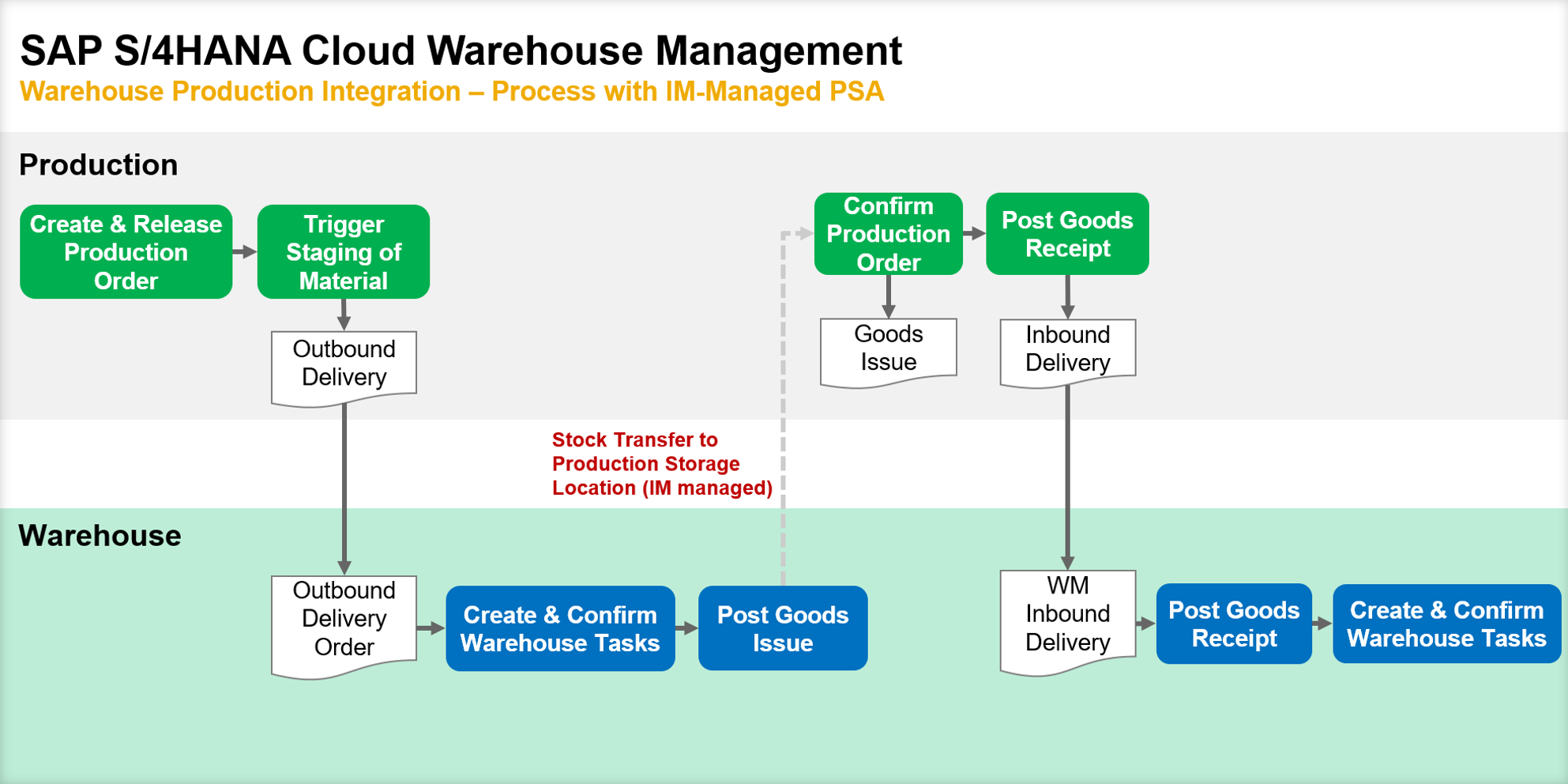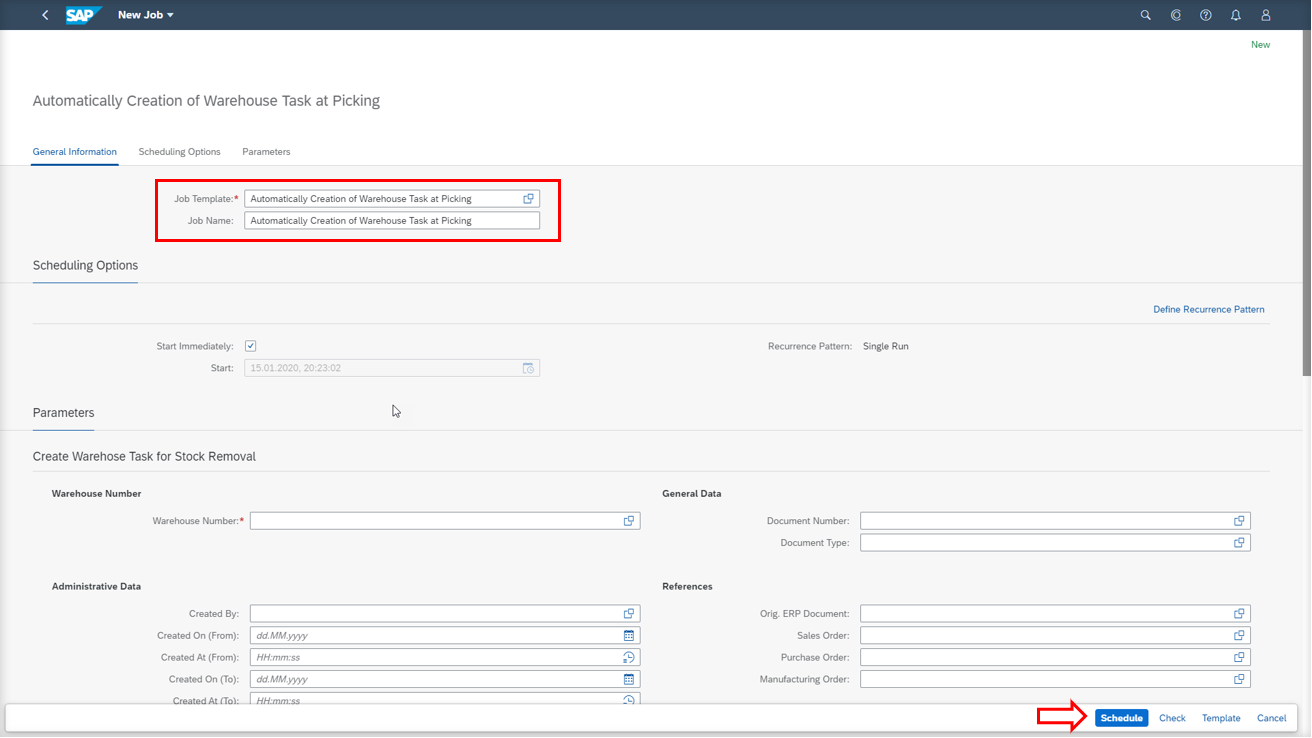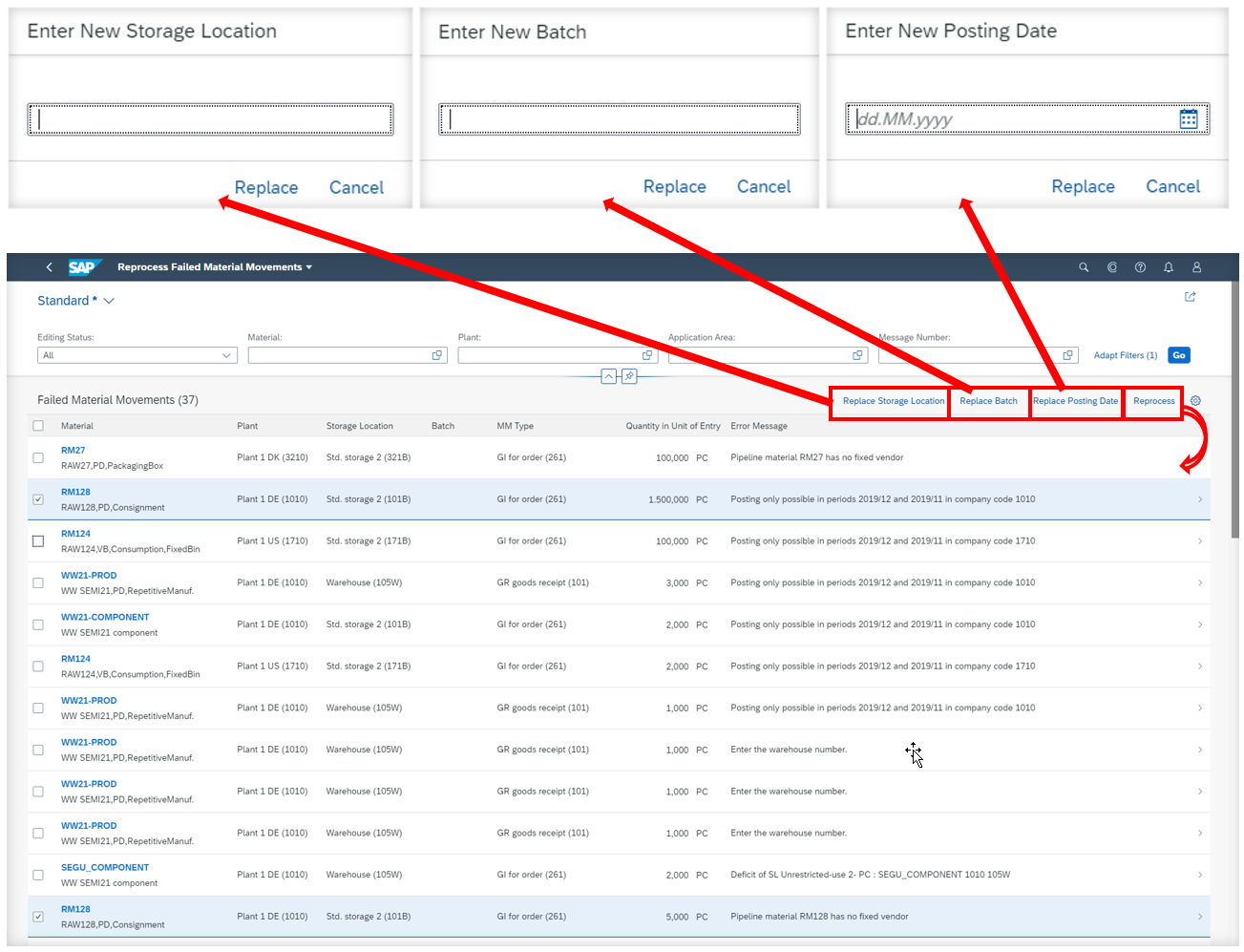
- SAP Community
- Products and Technology
- Enterprise Resource Planning
- ERP Blogs by SAP
- Manufacturing and Supply Chain in SAP S/4HANA Clou...
- Subscribe to RSS Feed
- Mark as New
- Mark as Read
- Bookmark
- Subscribe
- Printer Friendly Page
- Report Inappropriate Content
Here is the table of contents:
1. Warehouse Management
1.1. Bin Managed Production Stock & Synchronous Postings
1.2. Serial number handling in Warehouse Management
1.3. Automatically Creation of Warehouse Task at Picking
1.4. Attachment Services for Inbound and Outbound Deliveries
1.5. Overview of APIs in Warehouse Management
2. Inventory Management
Cycle counting as part of the physical inventory process
3. Quality Management
3.1. Resolve internal problems by using the 8-D methodology
3.2. Serial number handling in Quality Management
4. Production Planning and Execution
4.1. Predictive Material and Resource Planning (pMRP)
4.2. Capacity Planning
4.3. Reprocess failed material movements
4.4. Interfaces (APIs)
5.Just-in-Time Processing
Watch my video in which I present the following innovations:
- Lean integration between production and warehouse managed on bin level
- Serial number handling in Warehouse Management and in Quality Management
- 8-D problem-solving process in Quality Management
1. Warehouse Management
Warehouse Management is available as an integral part of SAP S/4HANA Cloud since the 1811 release. Meanwhile 12 best practice processes are available:

Fig. 1: Overview of Best Practice Processes in SAP S/4HANA Cloud - Warehouse Management
Get process flow diagrams and test scripts from the SAP Best Practices Explorer.
As mentioned in my video, Warehouse Management is strongly represented in the SAP S/4HANA Cloud 2002 release with a multitude of innovations.The following figure gives an overview of innovations in the 2002 release and also a review of innovations in 1911.

Fig. 2: Overview of innovations in Warehouse Management within the releases 2002 and 1911
1.1. Lean integration between production and warehouse - Bin Managed Production Stock & Synchronous Postings
To produce semi-finished and finished products it is usually necessary to stage components that are needed for the production process to the production supply area close to the machines where they will be consumed.

Fig. 3: Process Overview of scope item Warehouse Production Integration (3DV)
So far, production supply areas used in SAP S/4HANA Cloud could only be assigned to Inventory (IM) managed storage locations.

Fig. 4: Warehouse Production Integration - Process with Inventory managed PSA
With the 2002 release, production supply areas can be assigned to Warehouse (WM) managed storage locations as well.

Fig. 5: Bin managed production stock - Process with Warehouse managed PSA
This has the effect that the components staged to a production supply area can be managed on storage bin level. The benefits are obvious:
- The lean integration between production and warehouse increases stock transparency as stock in production is managed on a more-granular level.
- The goods receipt can be posted directly and synchronously (without inbound delivery) in the warehouse.
- Components can be consumed directly from the warehouse (without posted goods issue).
The following video (5:20 min duration without voice over) presents a system demo which shows you how to activate and use the integration between production and warehouse, managed on bin level. The system demo consists of 4 parts using different business roles:
1. Configuration Expert - Business Process Configuration (SAP_BR_BPC_EXPERT)
The user opens the Manage Your Solution app, navigates to the Shop Floor Control configuration, views the Production Scheduling Profile YW0002 with the setting for parameter Post Synchronously to Bin.
2. Master Data Specialist - Product Data (SAP_BR_PRODMASTER_SPECIALIST)
The user displays the material master of the BOM header material SG242 and shows on the work scheduling view where the Production Scheduling Profile YW0002 is maintained.
3. Production Engineer - Discrete Manufacturing (SAP_BR_PRODN_ENG_DISC)
The user opens the Manage Production Versions app and displays the production versions of material SG242. On the details screen of the production version data like Warehouse Number, Issue Storage and Receiving Location, Destination Bin and Default Supply Area are maintained. Additionally the user displays the Bill of Material with header material SG424 and component RM124.
4. Warehouse Operative (EWM) (SAP_BR_WAREHOUSE_OPERATIVE_EWM)
Last but not least the user opens the SAP Fiori app 'Process Warehouse Tasks - Internal Movement' and selects Warehouse Tasks which are assigned to a Manufacturing Order.
1.2. Serial number handling in Warehouse Management
With the 2002 release, it is possible to handle serialized products in the warehouse. For this purpose, new serial number profiles are available to support integrated processes with warehouse management. The SAP Fiori apps Change Inbound Deliveries, Run Outbound Process and Pack Outbound Deliveries have been enhanced to allow for serial number assignments.

Fig. 6: SAP Fiori app 'Run Outbound Process' with serial number handling
1.3. Automatically Creation of Warehouse Task at Picking
The new SAP Fiori app Schedule Warehouse Task Creation - Picking enables you to automate the picking warehouse task creation via a job running in background. You can define the outbound deliveries for automatic picking warehouse task creation based on various filter criteria like warehouse number, document no/type, shipment data, product data, etc.

Fig. 7: SAP Fiori app 'Schedule Warehouse Task Creation - Picking'
1.4. Attachment Services for Inbound and Outbound Deliveries
You can now attach additional files to warehousing documents (for example photos, videos, plain text documents or other kind of media files).
You can create, read, update or delete attachments using the apps
- Change Inbound Deliveries
- Run Outbound Process
- Warehouse Monitor

Fig. 8: SAP Fiori app 'Change Inbound Deliveries' with attachment service
1.5. Overview of APIs in Warehouse Management
With the 1905 release, we have delivered the scope item Resource Management in Warehousing (3W0) which allows you to leverage interfaces (APIs) for the development of customer-specific apps for warehouse task processing on mobile devices. For more details review my 1905 blog.
The following figure gives you overview of the APIs which are currently available in Warehouse Management.

Fig. 9: Overview of interfaces (APIs) in Warehouse Management. Note: The shown mobile device app is a prototype only and not available as a standard product.
2. Inventory Management
Cycle counting as part of the physical inventory process
With the 1911 release, we have started to provide cycle counting in physical inventory for SAP S/4HANA Cloud customers (see chapter 1.2. in my 1911 blog).
With the 2002 release, the new SAP Fiori app Cycle Counting Classifaction enables an inventory manager to improve operation efficiency by classifying materials for cycle counting as part of the physical inventory process. You can
- manage classifications for materials in stock based on the cycle-counting settings maintained in the self-service configuration UI Cycle Counting,
- remove an existing classification if the material should not be part of the cycle-counting method anymore,
- establish classification settings that mirror company requirements and that optimize preparation for your physical inventory process; define these settings once or whenever an adaptation is necessary.

Fig. 10: SAP Fiori app 'Cycle Counting Classification'
3. Quality Management
3.1. Resolve internal problems by using the 8-D methodology
The 2002 release enables continuous improvement through the standardized 8-D problem-solving process in Quality Management. The 8-D methodology supports you to identify, correct, and eliminate recurring problems.
Starting point of the new 8-D problem-solving process is a recorded defect with high impact which should be resolved sustainably. For this purpose, the quality engineer can start the new Problem- Solving Process within the Record Defect app. The new SAP Fiori app Resolve Internal Problems enables the quality engineer to process issues according to the 8-D methodology which consists of 8 standardized steps like corrective and preventive actions. Here is the list of predefined steps:
- D1 Team
- D2 Problem description
- D3 Containment actions
- D4 Root causes
- D5 Chosen permanent corrective action(s)
- D6 Implemented permanent corrective action(s)
- D7 Actions to prevent recurrence
- D8 Congratulate your team
The 8-D methodology is typically used in automotive and discrete industries.

Fig. 11: Start the 8-D problem-solving process via the 'Record Defect' app. You can also open the SAP Fiori app 'Resolve Internal Problems' directly with the tile of the same name.
The following video (30 sec duration without voice over) presents a short system demo which shows how the 8-D methodology is used for resolving an internal problem in Quality Management. Starting point is a defect. The quality technician (business role SAP_BR_QUALITY_TECHNICIAN) displays a defect via the SAP Fiori app Record Defect and navigates on the Problem-Solving Process tab to the new SAP Fiori app Resolve Internal Problems where you can see the 8 predefined steps of the standardized 8-D methodology.
3.2. Serial number handling in Quality Management
Now, serial number handling is not only enabled in Warehouse Management (see chapter 1.2.), but also in Quality Management.
The result details page of the SAP Fiori app Record Inspection Results enables the quality technician to perform the results recording for characteristics with single results in an inspection lot with a serialized material. With this innovation you can record the results for characteristics flexibly and effectively in inspection lots for both serialized and non-serialized materials.

Fig. 12: SAP Fiori app 'Resolve Inspection Results': You can record as many single results in an inspection lot as serial numbers are assigned to a serialized material. The red box borders the maintained serial numbers.
4. Production Planning and Execution
4.1. Predictive Material and Resource Planning (pMRP)
Short recap: As described in my 1908 blog and 1911 blog, Predictive Material and Resource Planning (pMRP) is our new simulative mid- and long-term planning tool. Thanks to the speed of HANA, it quickly propagates changed demand. The goal of pMRP is to identify potential capacity issues and to evaluate possible solutions as early as possible.
With the 2002 release, a new view Simulation Components is available in the Process pMRP Simulations app. It displays all the material components of a pMRP simulation which enables the production planner to check the demand quantities for each component per time period (month or week). You can switch between the Materials perspective and the Supply perspectives to focus on the component list grouped by component and production line or grouped by supplier and component. Besides the capability to review planned component consumption based on simulated changes, you can use the export to excel feature to share the forecast with the stakeholders.

Fig. 13: pMRP Simulation Components view with Supply perspective
When you release a simulation in the Process pMRP Simulations app, you can select a PIR (Planned Independent Requirements) version for subassembly components and choose to activate it right away or not.

Fig. 14: SAP Fiori app 'Process pMRP Simulations': Choose the PIR (Planned Independent Requirements) version when releasing a pMRP simulation
4.2. Capacity Planning
Since the 1908 release, the SAP Fiori app Monitor Work Center Schedules gives you an overview of the operations performed at your work centers by visualizing their schedules over a time period (see my 1908 blog).
Meanwhile we have enhanced the Monitor Work Center Schedules app with further capabilities:
With the 1911 release, the app enables you to display alternative routings on the orders schedule overview and gives you insights into the load of current and alternative work centers. Furthermore unsaved order changes can be displayed.
In addition, you can now view time periods for which shifts or intervals do not exist for work centers.

Fig. 15: SAP Fiori app ' displays work center non working time
Also, three new filters namely, Setup Group Key, Setup Group Category, and Work Center Group are now available. The Industry Type parameter in the app settings allows you now to choose between process industry and discrete industry.

Fig. 16: 'Industry Type' setting within app 'Monitor Work Center Schedules'
If you choose the Industry Type - Process in the app settings, the phase details will be displayed in the Schedule Production app and the Monitor Work Center Schedules app.

Fig. 17: SAP Fiori app 'Schedule Production' with process industry setting displays order operation phases
4.3. Reprocess failed material movements
With the SAP Fiori app 'Reprocess Failed Material Movements' the production operator or production supervisor can display a list of unsuccessful materials movements along with the related error
messages. This allows you to identify why the material movements failed. Using the navigation options provided, you can then correct the relevant issue (for example, in the material master data) and then reprocess the material movement.
You can use this app to:
● search through the list of failed material movements using a range of filters,
● view material data (such as plant, storage location, and batch) and the error messages for the failed material movements,
● use navigation options to display the product master, assign a revision level, or monitor availability,
● reprocess failed material movements for one or more selected materials,
● replace the storage location, batch, or posting date values for one or more selected materials.

Fig. 18: SAP Fiori app 'Reprocess Failed Material Movements'
4.4. Interfaces (APIs)
In this chapter I want to draw your attention to new, extended and deprecated API interfaces:
- SOAP API Manufacturing Order – Send enhanced to handle characteristics, long texts, operation status, additional fields like MateriaIsCoProduct, DebitCreditCode, InventorySpecialStockType
- OData API based on Read API for Master Recipe
- OData API based on Read API for Production Routing
- OData API Production Order (Version 2)
This API is the successor of the deprecated API Production Order (Deprecated).
Note: Some improvements in version 2 are incompatible changes compared to version 1.
5. Just-in-Time Processing
Last but not least coming to Component Manufacturing and Just-in-Time (JIT) processing.
JIT Supply to Customer allows you to run just-in-time processes with your customers for products delivered from stock or manufactured based on JIT requests.
You can receive and process delivery schedules to JIT sales scheduling agreements for planning and production purposes, receive summarized or sequenced JIT calls for shipping purposes.
Capabilities:
- Manage JIT master data for enabling JIT processing
- Manage JIT sales scheduling agreements and process forecast delivery schedules
- Receive JIT calls from customers or create and edit them manually
- Analyze stock availability for JIT call components
- Release and confirm production for JIT calls
- Create outbound deliveries for JIT calls
- Update of JIT calls through delivery processing and billing
The following figure gives you an overview of the process steps and the SAP Fiori apps for Just-in-Time processing:


Fig. 19: Overview of the process steps and SAP Fiori apps for Just-in-Time processing
If you compare the current overview of the JIT SAP Fiori apps with figure 19 in my 1908 blog, you will see that many new apps have been added for JIT processing since the 1908 release.
For more information on SAP S/4HANA Cloud, check out the following links:
- SAP S/4HANA Cloud release info: http://www.sap.com/s4-cloudrelease
- Sven Denecken’s SAP S/4HANA Cloud 2002 Release Blog
- The Link Collection for Manufacturing and Supply Chain here
- Quarterly release product videos on our SAP S/4HANA Cloud playlist
- Early Release Webinar Series here
- Inside SAP S/4HANA Podcast here
- Best practices for SAP S/4HANA Cloud here
- SAP S/4HANA Cloud Customer Community: here
- Feature Scope Description here
- What’s New here
- Help Portal Product Page here
- Implementation Portal here
- SAP Managed Tags:
- SAP S/4HANA,
- SAP S/4HANA Public Cloud
You must be a registered user to add a comment. If you've already registered, sign in. Otherwise, register and sign in.
-
Artificial Intelligence (AI)
1 -
Business Trends
363 -
Business Trends
21 -
Customer COE Basics and Fundamentals
1 -
Digital Transformation with Cloud ERP (DT)
1 -
Event Information
461 -
Event Information
23 -
Expert Insights
114 -
Expert Insights
151 -
General
1 -
Governance and Organization
1 -
Introduction
1 -
Life at SAP
415 -
Life at SAP
2 -
Product Updates
4,685 -
Product Updates
205 -
Roadmap and Strategy
1 -
Technology Updates
1,502 -
Technology Updates
85
- Manage Supply Shortage and Excess Supply with MRP Material Coverage Apps in Enterprise Resource Planning Blogs by SAP
- The Role of SAP Business AI in the Chemical Industry. Overview in Enterprise Resource Planning Blogs by SAP
- Futuristic Aerospace or Defense BTP Data Mesh Layer using Collibra, Next Labs ABAC/DAM, IAG and GRC in Enterprise Resource Planning Blogs by Members
- Functional Highlights of the New 3.0 Release of PLM System Integration for SAP S/4HANA in Enterprise Resource Planning Blogs by SAP
- SAP Continuous Influence for SAP S/4HANA Cloud Public Edition – Outcome of the Q1/2024 Review in Enterprise Resource Planning Blogs by SAP
| User | Count |
|---|---|
| 5 | |
| 4 | |
| 4 | |
| 3 | |
| 3 | |
| 3 | |
| 2 | |
| 2 | |
| 2 | |
| 2 |